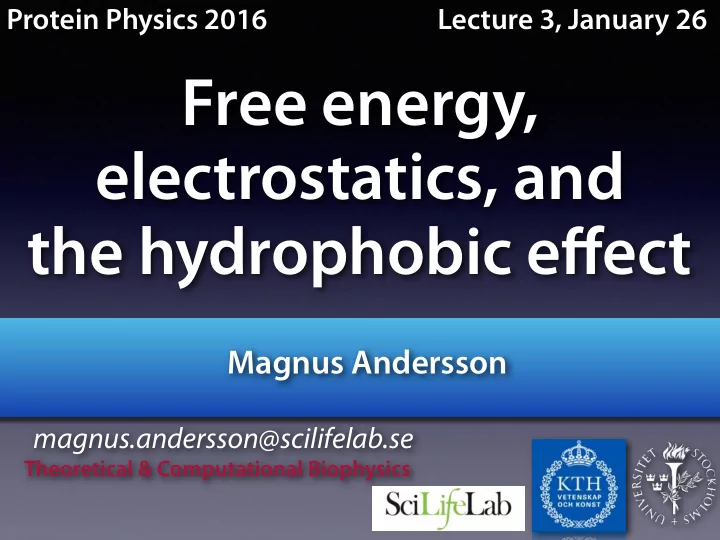

Protein Physics 2016 Lecture 3, January 26 Free energy, electrostatics, and the hydrophobic e ff ect Magnus Andersson magnus.andersson@scilifelab.se Theoretical & Computational Biophysics
Recap • Protein structure • Electrostatics & hydrogen bonds • Van der Waals / Lennard-Jones • Interaction strengths • Energy Landscapes • The Boltzmann Distribution • Free Energy and entropy
To sum up last week • Two critical results: • Protein folding is about conformations of long polypeptide chains - how can it fj nd the best structure? • Reaction directions are determined by free energy; F=E-TS. Stable states are F minima.
Outline today • Hydrophobic e ff ect revisited • Connection to F = E - TS • Connection to protein folding • Strength of electrostatics in proteins • Titratable amino acid side chains
Water Phase Transitions • Systems wants to stay at lowest F • ICE: Low E, low low S • Water: Higher E, higher S • When temperature is low, fj rst term (E) dominates F=E-TS • When temperature is high, second term (TS) dominates F=E-TS • Can we use this to understand
Vacuo Water Gain: Energy of 1 h-bond (E H <0) Loss: Entropy of 1 (0.5*2) freely rotating water (S H >0)
Peer challenge Which is true for H-bond formation at room temperature? A) E H < TS H B) TS H < E H Don’t forget the sign!
F H = E H - TS H
H-bond Δ G for proteins State A State B In vacuo D A D Δ G? A In solvent D D A A Δ G?
Why do some molecules like oil/gas better? Why do some molecules like water better?
Partitioning • Consider transfer of hydrocarbon to H 2 O • Concentrations (X) rather than probability • Count per mol, so we use R instead of k • X ∝ exp{-G/RT} • ∆ G liq->aq = -RT ln (X aq /X liq )
9.25 mol/l Δ G liq ➝ aq =+6.7kcal/mol 0.0001 mol/l
Hydrocarbon transfer • ∆ G liq->aq =+6.7 kcal/mol at room temp • Not spontaneous process • It costs free energy to solvate hexane in H 2 O • Why? G= H - TS
Δ G? Δ S? Δ H? Δ G= Δ H - T Δ S
Thermodynamic T • Minor perturbations at equlibrium • F+dF = 0 F + dE - TdS - SdT = 0 • At equilibrium under constant V & T, this leads to: dF=dE-TdS=0 • or: T = dE/dS • This was the thermodynamic de fj nition of temperature that we covered last week
S vs. Temperature • dF=d(E-TS)=dE-TdS-SdT • at equilibrium, dE-TdS=0 (last slide) • Thus, at constant volume we get: S=-dF/dT • And at constant pressure it is S=-dG/dT • Compare T = dE/dS from last slide • This solves our problem! • Measure G at multiple T to get S!
Hydrophobic solvation We can compare the gas phase with aqueous or liquid phases the same way! Knowing Δ G(T), we can calculate the other properties!
Hydrophobic e ff ect Can you account for these processes? Δ G? Δ S? Δ H? Clathrate structures
Temperature dependence • Strong dependence for H • Strong dependence for TS • G is a small di ff erence!
Thermodynamic data ∆ G virtually proportional to area!
Accessible surface area Probe radius 1.4Å “Solvent accessible surface area”
Amino acid area • For amino acids, we get very good agreement if we remove ~50Å 2 per polar atom!
Hardening of structure • What happens after hydrophobic collapse? Once we have a separate hydrophobic phase, the cost is very low to “harden” it, or even form a crystal What does this mean for proteins?
What about proteins? • Folding moves hydrophobic residues from water to liquid/ interior phase • Opposite process to solvation, so we use the opposite sign • or.... • Flip the plots!
Protein stability Free energy of ‘unfolding’ Solvate hydrocarbon in water, like we did earlier Free energy of ‘folding’ ( fm ipped y axis) Going from water to hydrocarbon, which is the opposite process
Δ G of Protein Folding 90% Hydrophobic e ff ect 10% “Polishing” (Van der Waals packing)
Electrostatics • So, hydrogen bonds are important • Governed by electrostatics • V=q 1 q 2 / ε r • What is ε for us?
Cost of forming charge protein
Charged amino acids ‘Titratable’
Charges in protein • It costs roughly 40kcal to introduce a unit charge in a protein ( ε =3)! • Compare to ~1.5kcal in water ( ε =80) • In practice, charges are rare inside proteins • Titratable amino acids typically uncharged instead.
Compare Hydrogen bonds? kT? (thermal energy) Stability of a protein?
What is ε in a protein?
Screening of charges
Electrostatics Permittivity, Ɛ (farads/m) Jens Erik Nielsen, JACS, 2013 Brian Mazzeo, JPCB, 2011
Electrostatics on the atomic level Vacuo + - V=q 1 q 2 / ε 0 r
In a medium
And even closer... ε ?
What is ε in the last slide? 100 kcal/mol A) ε ≅ 1 30 kcal/mol B) ε ≅ 3-4 6 kcal/mol C) ε ≅ 20 1.5 kcal/mol D) ε ≅ 40-80
Salt solubility in water Energy between two charges at 3Å with ε =80: 1.5kcal/mol Compare with hydrogen bonds!
Summary • Protein folding is largely determined by hydrophobicity • Hydrophobic e ff ect • Applications of enthalpy, entropy • Free Energy of processes • Protein folding, “molten globule” • Electrostatics in water is mostly entropy! • Chapters 5 & 6 in the Protein Physics book
Recommend
More recommend